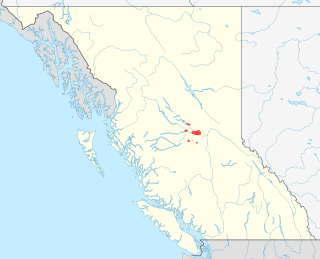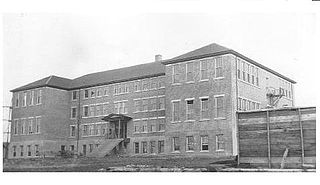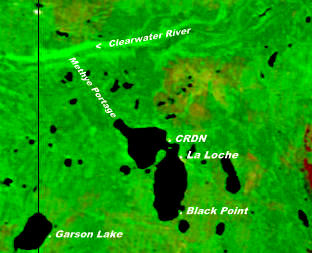Related Research Articles

The Slavey are a First Nations indigenous peoples of the Dene group, indigenous to the Great Slave Lake region, in Canada's Northwest Territories, and extending into northeastern British Columbia and northwestern Alberta.

The Dakelh or Carrier are the indigenous people of a large portion of the Central Interior of British Columbia, Canada.

Sekani or Tse’khene are a First Nations people of the Athabaskan-speaking ethnolinguistic group in the Northern Interior of British Columbia. Their territory includes the Finlay and Parsnip River drainages of the Rocky Mountain Trench. The neighbors of the Sekani are the Babine to the west, Dakelh to the south, Dunneza (Beaver) to the east, and Kaska and Tahltan, to the north, all Athabaskan peoples. In addition, due to the westward spread of the Plains Cree in recent centuries, their neighbors to the east now include Cree communities.

The Dakelh (ᑕᗸᒡ) or Carrier language is a Northern Athabaskan language. It is named after the Dakelh people, a First Nations people of the Central Interior of British Columbia, Canada, for whom Carrier has been a common English name derived from French explorers naming of the people. Dakelh people speak two related languages. One, Babine-Witsuwit'en is sometimes referred to as Northern Carrier. The other includes what are sometimes referred to as Central Carrier and Southern Carrier.

The Wetʼsuwetʼen are a First Nation who live on the Bulkley River and around Burns Lake, Broman Lake, and François Lake in the northwestern Central Interior of British Columbia. The endonym Wetʼsuwetʼen means "People of the Wa Dzun Kwuh River ".
Edward John is a prominent First Nations political leader in Canada.
Tl'azt'en Nation is a First Nations band located along the north shore of Stuart Lake near the outlet of the Tache River, in the northern interior of British Columbia. The main village belonging to Tl'azt'en Nation is Tache, 60 km north-west of Fort St. James.The small settlements of Middle River (Dzit'lain'li).on Trembleur Lake and Grand Rapids, along the Tache River between Stuart Lake and Trembleur Lake also belong to Tl'azt'en Nation. The main administrative offices are in Tache, as a school - Eugene Joseph Elementary School, Daycare, Head Start, Health Unit, Education Centre/ Learning Centre for Adults, RCMP/ Justice Office, Public Works building that supplies diesel and gasoline, water treatment plant, a newly built youth recreation center (2012), a Catholic and Christian church, one in Old Tache and one in "sunny side", a volunteer fire department with a fire hall; rec sites include a paintball park, a basketball court and a hockey rink. The village of Portage once belonged to Tla'zt'en Nation but separated in 1994 as Yekooche First Nation. The village of Pinchie once belonged to Tl'azt'en Nation separated on March 12, 2019 and is now the Binche Whut'en First Nation. Prior to 1988 Tl'azt'en Nation was known as the Stuart-Trembleur band. Tl'azt'en Nation belongs to the Carrier Sekani Tribal Council.

The Wetʼsuwetʼen First Nation is a Wetʼsuwetʼen First Nations band located outside of the village of Burns Lake, British Columbia, Canada. It was formerly known as the Broman Lake Indian Band and is still usually referred to as Broman Lake although this is no longer its official name. Its members speak the Wetʼsuwetʼen dialect of Babine-Witsuwitʼen, a Northern Athabaskan language. The main community is on Palling Indian Reserve No. 1.
The Carrier Sekani Tribal Council is a tribal council representing six First Nations in the Central Interior of British Columbia. It was originally known as the Lakes District Tribal Council. The CSTC was incorporated in 1981 and is a registered non-profit society.

Babine Lake or Na-taw-bun-kut is the longest natural lake in British Columbia, Canada.
In Canada, an Indian band or band, sometimes referred to as a First Nation band or simply a First Nation, is the basic unit of government for those peoples subject to the Indian Act. Bands are typically small groups of people: the largest in the country, the Six Nations of the Grand River First Nation had 22,294 members in September 2005, and many have a membership below 100 people. Each First Nation is typically represented by a band council chaired by an elected chief, and sometimes also a hereditary chief. As of 2013, there were 614 bands in Canada. Membership in a band is controlled in one of two ways: for most bands, membership is obtained by becoming listed on the Indian Register maintained by the government. As of 2013, there were 253 First Nations which had their own membership criteria, so that not all status Indians are members of a band.

Lejac Residential School was a Canadian residential school in British Columbia that operated from 1922 to 1976 by the Roman Catholic Church under contract with the Government of Canada.
Cunningham Lake is situated approximately 91 kilometres from Fort St. James, British Columbia via Lind Pit Lake road. Nankut Creek connects Cunningham to Stuart Lake.
Lake Babine Nation is a Babine band government, historically located on the banks of Babine Lake in central British Columbia, Canada. Its main community has been in Woyenne, near Burns Lake, since many of the nation's members moved there in the 1940s. Other year-round communities include Tachet on the central part of Babine Lake and Wit'at at the end of the northwest arm of the lake. Seasonal communities include Nedo'ats at the north end of the lake and Donald's Landing toward the south end.
Takla Lake Nation is a First Nation located around Takla Lake, 400 km north of Prince George, British Columbia, Canada. The main community is at Takla Landing, at the north end of Takla Lake, but the band services 17 reserves totaling 809 hectares. Takla Lake First Nation has approximately 650 members. It was created by the amalgamation of the Takla Lake and Fort Connelly bands in 1959.

The Nadleh Whut'en First Nation is a First Nations government of the Dakelh people, whose territory is located in the Central Interior of British Columbia, Canada, around the east end of Fraser Lake. The nation has seven reserves which Crown-Indigenous Relations and Northern Development Canada refer to as IR#1-9.. Until 1990, it was referred to as the Fraser Lake Indian Band.
The Carrier-Chilcotin Tribal Council is a First Nations tribal council located in the Chilcotin District of the Central Interior of the Canadian province of British Columbia, and also on the Fraser River near the city of Quesnel. It consists of three Carrier bands and one Tsilhqot'in band. The other Tsilhqot'in bands belong to the Tsilhqot'in National Government. Most other Carrier bands are either unaffiliated or belong to the Carrier-Sekani Tribal Council. The Tribal Council's offices are in Williams Lake.
The Cheslatta Carrier Nation or Cheslatta T'En, of the Dakelh or Carrier people (Ta-cullies, meaning "people who go upon water" is a First Nation of the Nechako River at the headwaters of the Fraser River.
The lack of treaties between the First Nations of British Columbia (BC) and the Canadian Crown, is a long-standing problem that has become a major issue in recent years. In 1763, the British Crown declared that only it could acquire land from First Nations through treaties. Historically only two treaties were signed with the First Nations of British Columbia. The first of which was the Douglas Treaties, negotiated by Sir James Douglas with the native people of southern Vancouver Island from 1850-1854. The second treaty, Treaty 8, signed in 1899 was part of the Numbered Treaties that were signed with First Nations across the Prairie regions. British Columbian Treaty 8 signatories are located in the Peace River Country or the far North East of BC. For over nine decades no more treaties were signed with First Nations of BC; many Native people wished to negotiate treaties, but successive BC provincial governments refused until the 1990s. A major development was the 1997 decision of the Supreme Court of Canada in the Delgamuukw v. British Columbia case that Aboriginal title still exists in British Columbia and that when dealing with Crown land, the government must consult with and may have to compensate First Nations whose rights are affected.

The Clearwater River Dene Nation is a Dene First Nations band government in the boreal forest area of northern Saskatchewan, Canada. It maintains offices in the village of Clearwater River situated on the eastern shore of Lac La Loche. The Clearwater River Dene Nation reserve of Clearwater River shares its southern border with the village of La Loche.
References
- ↑ "Yekooche First Nation: Reserves/Settlements/Villages". Crown–Indigenous Relations and Northern Affairs Canada . Government of Canada. 2008-11-03. Retrieved 2019-04-23.
- ↑ "Yekooche First Nation: Registered Population". Crown–Indigenous Relations and Northern Affairs Canada . Government of Canada. 2008-11-03. Retrieved 2019-04-23.
- ↑ "Yekooche, History of our People and our Village of Portage Fort St James, British Columbia". www.yekooche.com. Retrieved 2019-04-23.
- ↑ Reconciliation, Ministry of Aboriginal Relations and. "Yekooche First Nation - Province of British Columbia". www2.gov.bc.ca. Retrieved 2019-04-23.